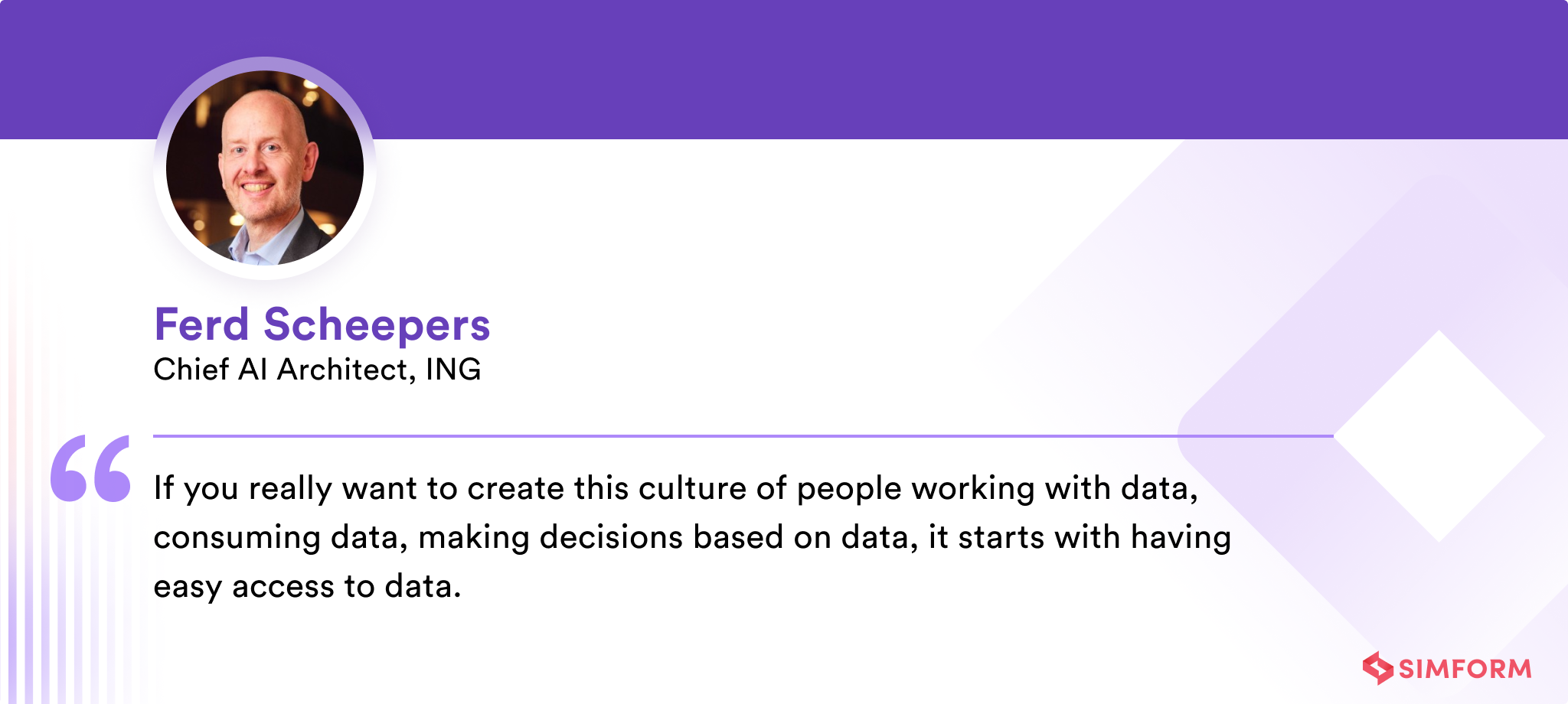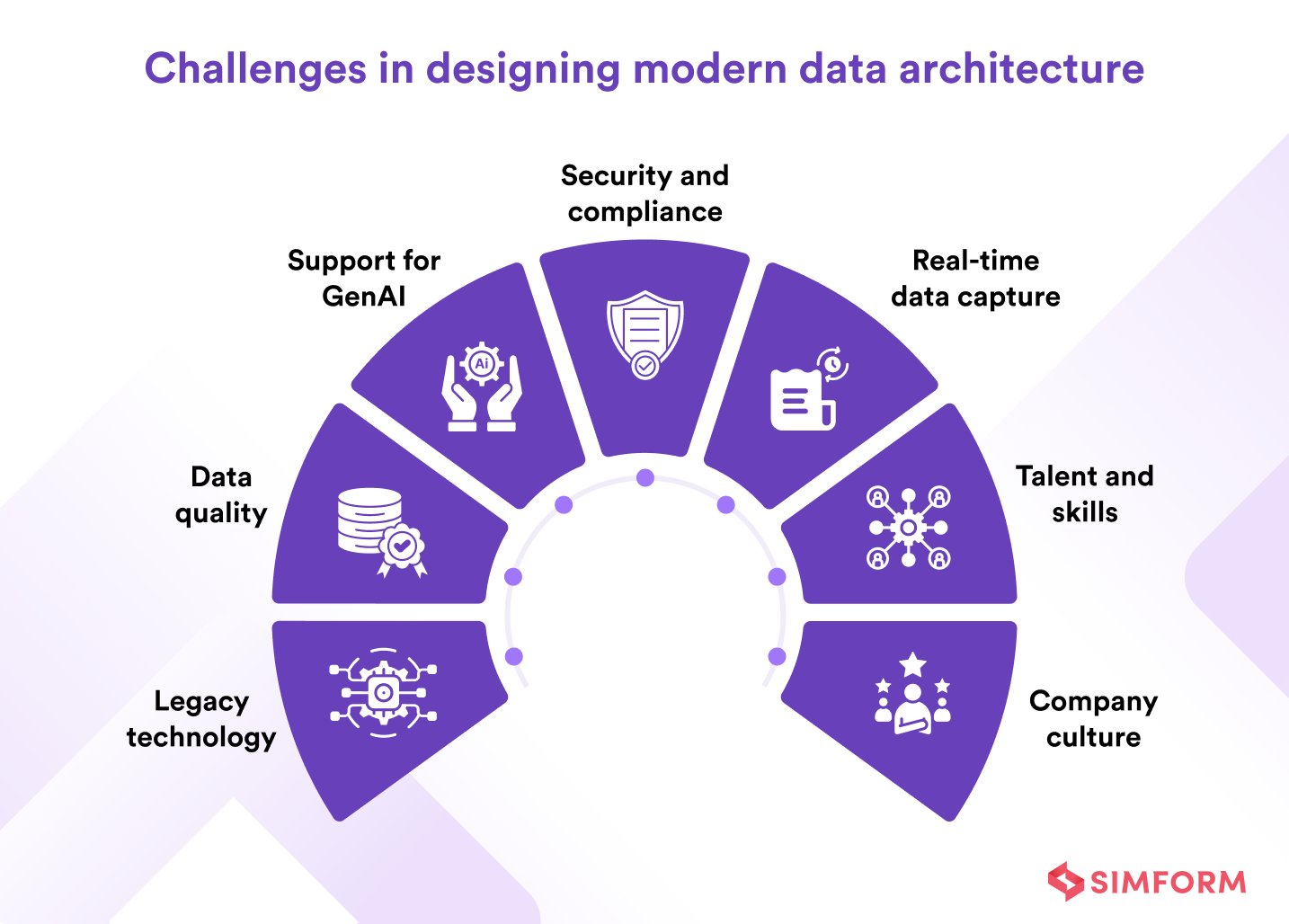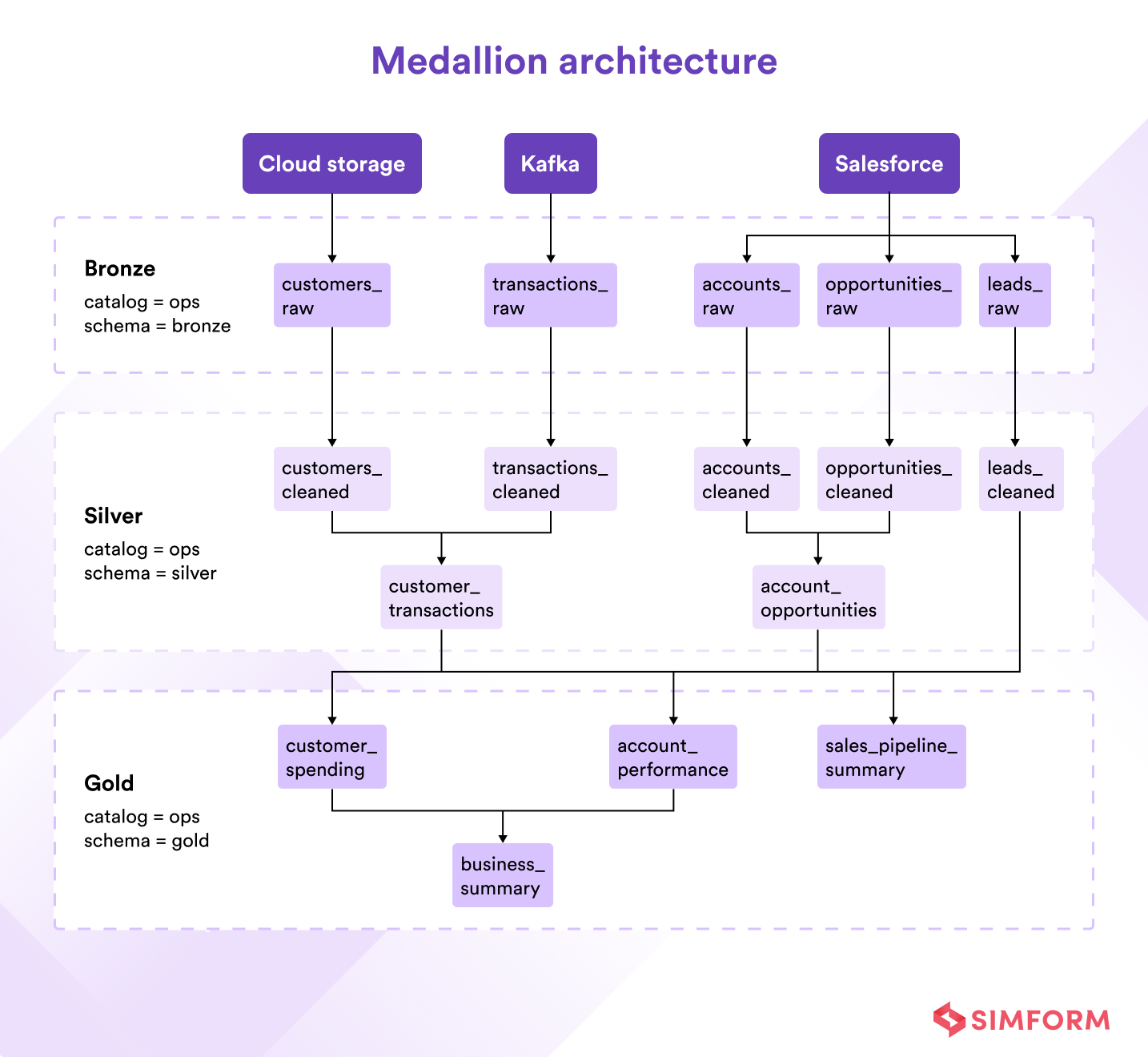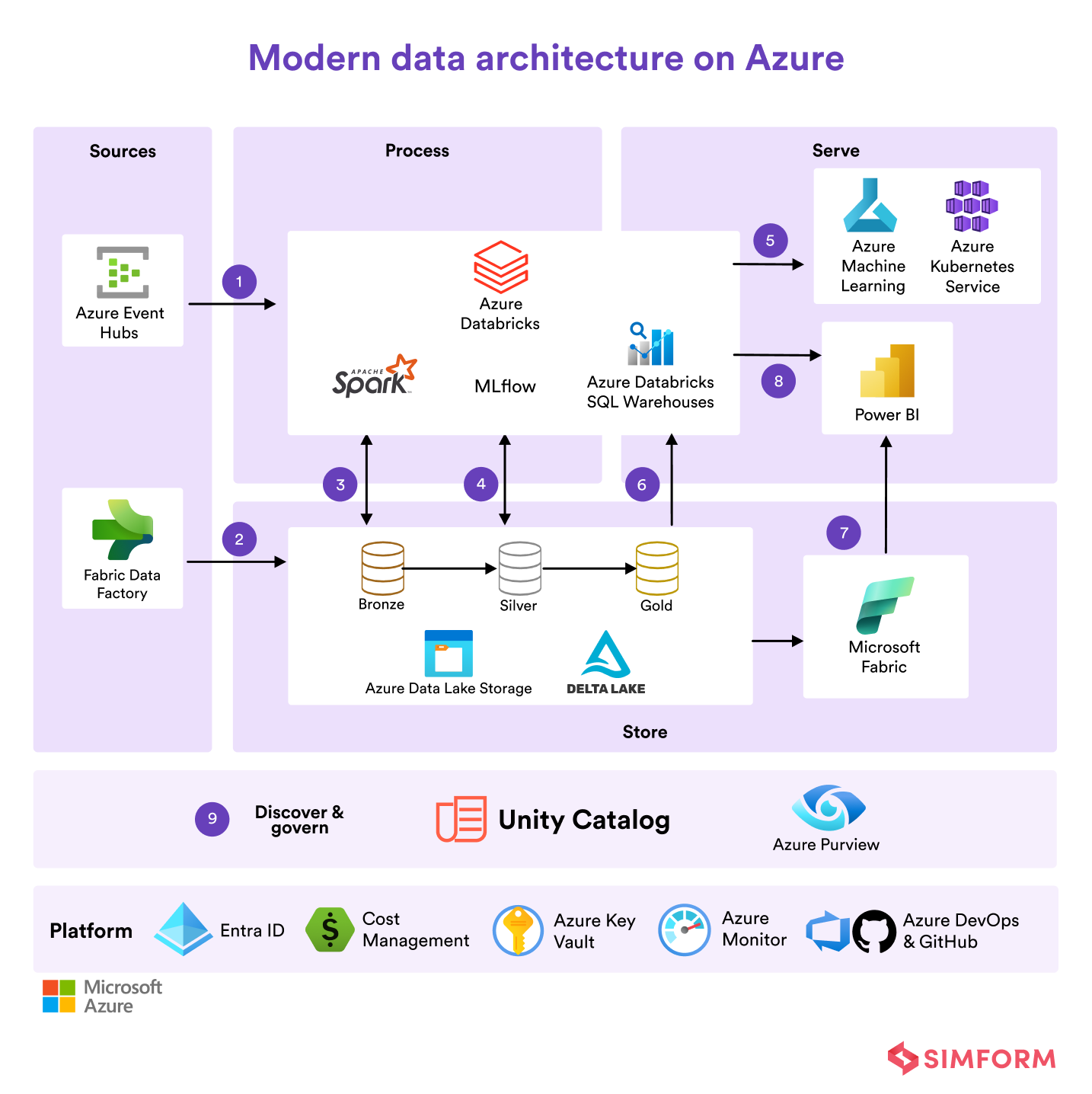Businesses today face an overwhelming flood of data from sources like IoT sensors, mobile apps, and social media platforms. This data arrives in diverse formats and volumes too large for traditional data systems to handle.
To make use of this data, organizations need a data architecture that can:
- Ingest vast streams of unstructured data continuously instead of handling small batches of structured data
- Enable real-time analytics to support critical functions like fraud detection and personalized recommendations
- Access raw, granular data to power advanced techniques like AI and machine learning
- Flexibly scale as data volumes grow exponentially
- Adapt to new data sources and evolving analytics needs
These capabilities are impossible with siloed legacy data infrastructure. What’s required is an elastic and versatile modern data architecture.
Azure provides building blocks to empower such next-gen data platforms through various services that bring useful features for efficiency and cost-effectiveness. This blog post offers a comprehensive guide on how Azure can help you transform data analytics by embracing modern data architecture.
What is modern data architecture?

Modern data architecture refers to the integrated systems, infrastructure, and processes that can support the analytics needs of contemporary organizations. It uses cloud, automation, and security capabilities to enable real-time, scalable access to centralized, unified data for advanced analytics and AI.
The key goals of modern data architecture are to:
- Connect disparate data sources into a cohesive whole
- Enable self-service access to trustworthy information
- Drive faster and more data-driven decision-making
- Support advanced analytics for actionable insights
- Allow modular expansion as requirements change
By removing data barriers, modern architectures promote democratizing information sharing and analysis. Its agility comes from integrated, modular components that support continuous innovation at scale.
Despite the benefits, why are organizations struggling to modernize their data architecture?
The promise of agility, scalability, and actionable insights makes modern data architectures irresistible. But the move from siloed on-premise systems requires mitigating some friction.

#1. Complexity of legacy systems
Legacy systems are rigid, built on outdated technology, and struggle to integrate with flexible, cloud-based systems. They share data in large, slow batches, creating bottlenecks for real-time analytics. Due to tangled internal dependencies, migrating off legacy systems is risky. While the cloud offers agility, legacy systems resist change and slow down progress.
#2. Need for maintaining reliable data quality
Bringing data from different units into a modern platform can spread inadequate or inconsistent data, causing downstream problems. Data teams struggle with differing definitions, a rapid influx of diverse data, difficulty tracing data origins, and unreliable third-party data. These issues lead to untrustworthy reports and analytics, making it hard to build confidence in data quality, especially for training AI models.
#3. Lack of support for Generative AI
Generative AI requires specialized data pipelines and governance frameworks, but many data infrastructures lack these capabilities. Key bottlenecks include insufficient high-quality datasets, limited tools for visualizing model inputs/outputs, poor data labeling and tagging, lack of sandboxed environments for experimentation, and inadequate model monitoring. These gaps risk overfitting, bias, and misinformation.
#4. Complex security and compliance requirements
Security and compliance risks increase as data grows and more users interact with systems. Automation APIs, multi-cloud environments, and a lack of audit functions complicate protection efforts. Modern data platforms need built-in security features like identity management, encryption, and monitoring, but gaps remain when no compliance-focused framework guides the architecture.
#5. Gaps in real-time data capture
Many companies struggle with ingesting and processing real-time data. Challenges include legacy systems using batch processing, bottlenecks in network bandwidth, difficulty parsing unstructured data, and data losing context as it moves between systems. Until modern architectures support continuous data capture and monitoring, significant effort goes into transporting raw data instead of enabling real-time analytics.
These challenges in designing a modern data architecture may seem daunting, but there is an easier way to overcome them, thanks to Azure’s various data engineering services.
How to design and implement modern data architecture on Azure?
Modern data architecture on Azure is designed to unify data, analytics, and AI workloads, run efficiently and reliably at any scale, and provide insights through analytics dashboards, operational reports, or advanced analytics.
Here are the core layers of modern data architecture and the relevant Azure services that support each layer:
#1. Data ingestion
The ingestion layer of your modern data architecture needs to reliably capture and handle data with different velocities, volumes, and formats.
Azure offers many ingestion services based on these needs.
Azure services for ingesting real-time data:
- Azure Event Hubs: Perfect for high-volume event streams from applications or even IoT devices. Can handle both batch and stream processing scenarios, giving you flexibility as needs change.
- Azure IoT Hub: Designed for device telemetry with built-in device security and management capabilities.
- Azure Service Bus: While not a primary ingestion service, it can support modern data architecture ingestion needs (when the volume is moderate) for enterprise messaging where guaranteed delivery is critical.
Azure services for batch processing:
- Azure Data Factory: For orchestrating complex workflows across various sources and performing batch processing tasks on a scheduled basis.
- Azure Databricks: Ideal for batch processing tasks that require advanced analytics or machine learning capabilities, especially when working with structured and unstructured data.
Most modern architectures combine multiple ingestion methods. For example, a retail system might use Event Hubs for real-time transaction processing while using Data Factory for nightly batch loads of inventory data.
The choice comes down to your specific business needs and cost considerations, as different services have different pricing models based on volume and performance requirements.
#2. Storage foundation
The storage layer forms the bedrock of your modern data architecture. All your data resides here and it affects how efficiently your applications can access and process that data.
When designing your storage foundation in Azure, the key considerations revolve around data characteristics (structured vs unstructured), access patterns (random vs sequential), performance requirements (IOPS, throughput, latency), and integration needs with your existing systems.
Top Azure services for data storage are:
- Azure Data Lake Storage Gen2: Hierarchical storage built on blob storage that combines big data processing with enterprise security controls. Best when you need petabyte-scale analytics while maintaining granular data access management.
- Azure Storage Blobs: Massively scalable object storage with hot/cool/archive tiers and automated lifecycle management. Choose it for cost-effective storage of any unstructured data with HTTP access and built-in redundancy options.
- Azure Cosmos DB: Multi-model database offering single-digit millisecond latency across global regions with 99.999% SLA. Best for applications requiring global data distribution with automatic scaling and no performance degradation.
- Azure Container Storage: Native Kubernetes storage service that automates volume provisioning and management. Best for standardizing storage operations across container workloads without manual intervention.
- Azure Files: Managed SMB/NFS file shares with hybrid connectivity and REST API support. Ideal when lifting-and-shifting file server workloads to cloud while maintaining existing application compatibility and adding cloud-native access.
#3. Data enrichment and transformation
The transformation layer converts raw data into analytics-ready formats while enriching it with business context and rules for downstream consumption. This layer needs to handle both batch and streaming transformations while maintaining data quality and lineage.
Top Azure services for data enrichment and transformation in modern data architecture:
- Azure Data Factory: Extends beyond the ingestion capabilities to handle enterprise ETL/ELT needs. The mapping data flows provide code-free transformation capabilities, ideal for when you need intuitive, code-free data processing while maintaining enterprise-grade reliability and monitoring.
- Azure Databricks: Enterprise-grade Apache Spark platform with collaborative notebooks and MLflow integration. Perfect for complex ETL pipelines requiring both SQL and programming interfaces, while supporting both batch and streaming transformations with Delta Lake’s ACID compliance.
Given the importance of maintaining data lineage and quality across these transformation services, we strongly recommend implementing a medallion architecture pattern that organizes your data lake into bronze (raw ingested data), silver (cleaned and standardized data), and gold (business-ready, enriched data) layers. This progressive refinement approach using Delta Lake format enables ACID compliance and schema enforcement while maintaining clear data lineage throughout your transformation journey.
Here’s an example:

Source: What is the medallion lakehouse architecture? – Azure Databricks | Microsoft Learn
#4. Data serving and analytics
The data serving layer provides access to processed and transformed data across different consumption patterns. It enables efficient querying, supports various analytical workloads, and prepares data for downstream applications and business intelligence tools.
Azure services for data serving:
- Azure Synapse Analytics: Unifies data warehousing and big data analytics in a centralized platform that supports both SQL-based and Spark-based analytics. It offers both serverless and provisioned query models so that you can match computational resources directly to workload requirements. Ideal for for large-scale analytics platform that integrates both structured and unstructured data, and needs to perform complex queries across massive datasets.
- Azure Stream Analytics: Processes real-time streaming data across multiple input sources with low-latency event handling. Use it for scenarios requiring immediate insights from IoT devices, application telemetry, or continuous data streams, as it easily integrates with other data services and makes the whole process quicker.
And of course, because services like Azure Databricks and Data Explore are end-to-end solutions, you can use those for data serving too.
#5. Machine learning integration
Machine learning is increasingly becoming an integral part of modern data architectures as organizations seek to operationalize ML at scale and reduce the friction between data processing and model deployment.
The choice of ML services depends heavily on factors like automation needs, model retraining frequency, inference latency, etc.
Top Azure services for ML and MLOps:
- Azure Machine Learning: End-to-end platform for model development, training, and deployment with Python/CLI interfaces and AutoML capabilities. Best for teams needing complete ML lifecycle management and custom model development, but requires specialized ML expertise and dedicated DevOps resources.
- Azure Fabric: Unified platform combining data engineering, analytics, and ML workloads. Ideal for organizations wanting to consolidate their data and ML operations under a single platform, but may sacrifice some specialized ML capabilities of standalone services.
- Azure AI Services: Pre-built AI APIs for common tasks like vision, speech, and language processing. Most effective for standard AI capabilities in applications without custom model requirements, but offers limited customization and can have unpredictable costs at scale.
- Azure SQL ML Services: In-database ML capabilities for Azure SQL Managed Instance. Useful for simple ML models that need to operate directly on SQL data, but limited in model complexity and modern ML framework support.
- Azure Synapse Analytics ML: Integrated ML capabilities within Synapse workspace. Best for teams already using Synapse for analytics who need basic ML capabilities, but lacks advanced MLOps features.
- Azure Databricks: Databricks also offers native ML support and MLflow integration. Optimal for data-intensive ML workloads requiring distributed computing, but comes with steep learning curve and potential platform lock-in.
#6. Business intelligence
The business intelligence layer operationalizes your entire data stack and presents processed data through interactive analytics interfaces. This is where your data platform transitions from a processing engine to an insights delivery system for both real-time operational needs and complex analytical workloads.
Azure services for business intelligence:
- Power BI: Enterprise analytics platform combining semantic modeling with advanced visualization capabilities. Best for organizations looking to standardize their analytics on a single platform, as it balances self-service flexibility with enterprise governance. Native integration with Azure Synapse enables live querying of your entire data estate.
- Power BI Embedded: Analytics embedding service that extends Power BI capabilities into your applications. Ideal when you need to integrate analytics directly into operational workflows and custom applications while maintaining consistent security and branding across platforms.
- Azure Synapse Analytics: For BI workloads, it acts as a high-performance query engine behind Power BI. The native integration means you can leverage features like materialized views and result-set caching while maintaining security and governance through a single platform.
- Azure Analysis Services: Enterprise semantic modeling layer that extends Power BI’s built-in capabilities. Best for organizations needing to maintain complex business logic and calculations across multiple reporting tools while ensuring consistent metric definitions.
#8. Governance and security
Without robust governance and security, your data platform cannot achieve reliability, scalability, or regulatory alignment.
Azure services for governance and security:
- Azure Policy: Policy-driven governance platform for defining and enforcing organizational standards across your Azure estate. Best for teams who need to reduce compliance overhead through automated guardrails – from developers integrating checks into CI/CD pipelines to security teams implementing centralized audit controls and automated remediation at scale.
- Defender for Cloud: A CNAPP (cloud-native application protection platform) solution that unifies security across multi-cloud environments, combining DevSecOps, CSPM (cloud security posture management), and CWPP (cloud workload protection platform) capabilities. This service is best when organizations manage multiple cloud platforms and need unified security visibility and control.
- Azure Resource Manager: A centralized service for deploying and managing Azure resources through declarative templates. This service is best when organizations must systematically deploy complex applications across multiple environments while maintaining consistent configurations, enforcing standardized access controls, and tracking resource dependencies.
- Azure Confidential Computing: Offers solutions to isolate sensitive data while it’s being processed. Ideal when teams must perform secure multi-party data analytics or ML operations across combined datasets while maintaining privacy between participating organizations, especially in regulated industries.
#9. Monitoring and optimization
The monitoring and optimization layer is critical for ensuring your data platform’s efficiency, reliability, and cost-effectiveness. It provides visibility into operations, enabling you to detect anomalies, identify inefficiencies, and fine-tune performance.
Azure services for monitoring and optimization:
- Azure Monitor: A comprehensive monitoring platform for cloud and on-premises environments that offers integrated data collection, analysis, and response capabilities. This service is best for organizations operating complex hybrid infrastructures that need unified visibility across multiple environments, require an automated incident response, and want to build custom monitoring solutions while maintaining seamless integration with Microsoft and third-party tools.
- Azure Application Insights: An application performance monitoring (APM) service within Azure Monitor that helps developers track, analyze, and optimize live web and mobile applications.
- Azure Network Watcher: A monitoring and diagnostics service for Azure IaaS resources, offering tools to analyze network health, troubleshoot connectivity issues, and capture network traffic data. This service is best for organizations to monitor VM network performance, diagnose VPN connectivity problems, or maintain security compliance through flow logs—without directly accessing their virtual machines.
- Azure Advisor: Provides personalized recommendations across reliability, security, performance, cost, and operational excellence. It analyzes resource configurations and usage patterns to deliver inline recommendations for improvement.
- Azure Reservations: A cost-saving solution that offers significant discounts of up to 72% on Azure services when you commit to one-year or three-year plans. This service is best when teams have predictable resource requirements and want to optimize their cloud spending through advance commitments rather than paying higher pay-as-you-go rates.
How is modern data architecture useful for data analytics?
Modern data architecture helps organizations get deeper insights from their data efficiently and cost-effectively. Its multi-engine approach enables analytics teams to process petabyte-scale datasets while maintaining fast query response times for business users.
With intelligent separation of storage and compute, organizations can run concurrent analytical workloads efficiently – whether it’s real-time operational analytics, interactive data exploration, or resource-intensive machine learning training. This flexibility ensures analytics teams can deliver insights at the speed of business while maintaining control over infrastructure costs.
Let’s see the benefits practically with a reference architecture shown below. This architecture uses Azure Databricks as the unified analytics engine. It implements a medallion architecture data lake that provides incremental processing and data quality controls across transformation stages.

Key components and their contributions:
- Azure Event Hubs provides reliable stream processing with configurable delivery guarantees and built-in checkpoint management for fault-tolerant real-time data pipelines and recovery.
- Microsoft Fabric automates data integration with change data capture support for compatible sources. Its centralized orchestration and dependency tracking reduce pipeline maintenance.
- Azure Databricks controls compute costs through automated cluster lifecycle management and configurable auto-scaling. It can persist computation states based on workload needs.
- MLflow provides automated versioning of models, parameters, and dependencies that enable reproducible experiments and model governance.
- Azure ML with AKS supports model deployments with configurable blue-green updates and A/B testing capabilities to minimize production impact during updates.
- Databricks SQL warehouses provide interactive query performance for concurrent users via query optimization and result caching. Performance scales with warehouse configuration.
- Microsoft Fabric maintains automated metadata management and cross-system lineage tracking for data flow and impact analysis.
- Power BI processes large-scale datasets through query folding and aggregation pushdown, with performance based on data model design and source capabilities.
- Unity Catalog provides centralized security through fine-grained access controls and sensitive data protection, while Purview adds enterprise-wide data governance and discovery capabilities.
These components create a data ecosystem that drives innovation while maintaining governance and control. Organizations can move faster, experiment more freely, and turn data into value more quickly than ever before.
Build modern data architecture with Azure Solution Partner
Building modern data architecture on Azure has challenges like integrating legacy systems, ensuring governance, managing costs, and needing more specialized skills. You need an Azure cloud and data engineering expert with years of experience and knowledge.
With 75+ Azure-certified engineers and 250+ Microsoft developers with specialized skills in .NET, SharePoint, and D365 platforms., Simform, an Azure Solution Partner for Data and AI, can help. Here’s how:
- Consult your team to define ideal use cases considering existing data infrastructure, data analytics goals, and resource constraints
- Design resilient, secure, and high-performance data architecture with optimal Azure data services
- Migrate and integrate legacy and on-premises data to your Azure environment
- Ensure governance, security, availability, and compliance as per standards
Want to enable your data-driven transformation on Azure? Request a free consultation call with our Azure data engineering experts.